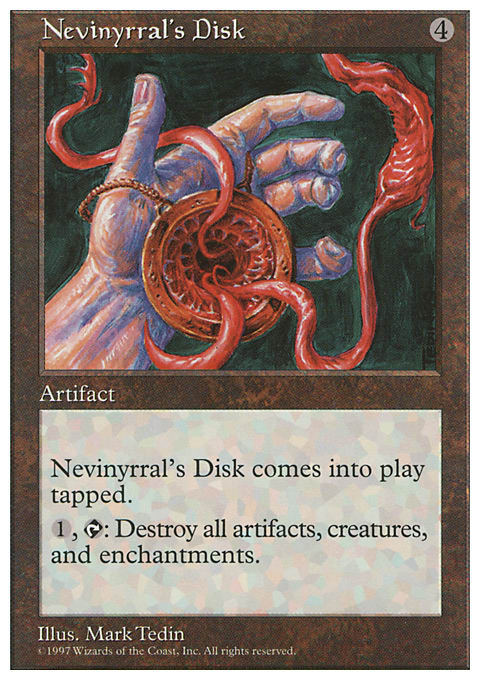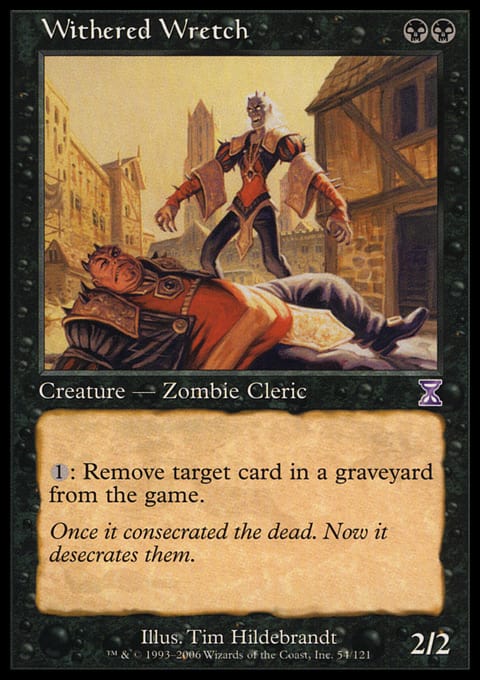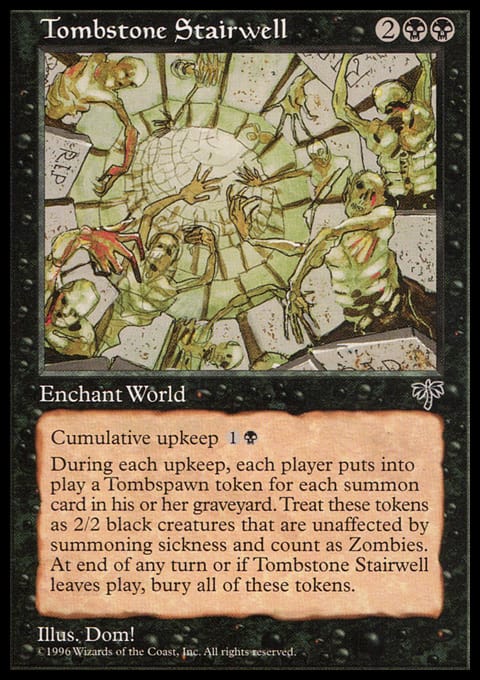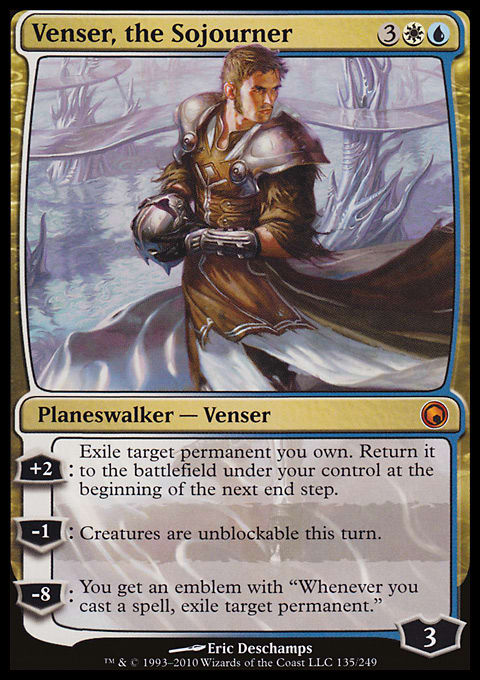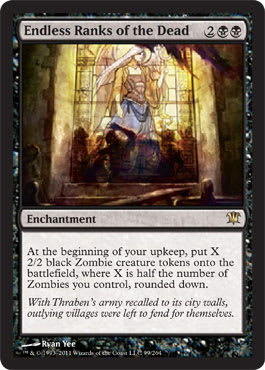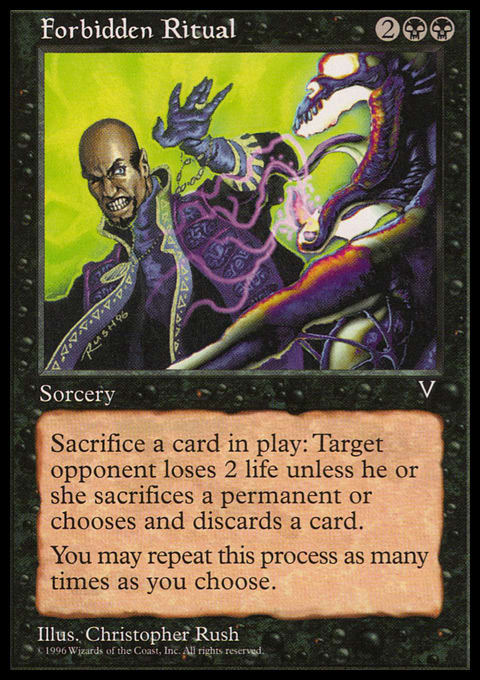Last week I finished up my Mikaeus, the Unhallowed commander deck—four months after he was printed, but then you don’t get to my position in the world without procrastinating at an Olympic level. The deck was based on a sixty-card zombie deck of mine that abuses the powerful synergies of cycling creatures and Tombstone Stairwell, and ended up as a strong zombie-tribal deck with a lot of cards that are strong on their own but devastating in concert with Tombstone Stairwell. On the whole, a strong and interesting build, but not quite as innovative and flat-out weird as I had hoped.
What’s Right with Mikaeus
I took it for a spin in our Wednesday-night casual games, most of which are Commander.
The first game was a three-way with Josh’s new Kemba build and Kevin’s new these-are-not-the-droids-you’re-looking-for Karona deck, which is based on the idea that we can attack anyone we like with Kevin’s Karona as long as we don’t attack Kevin. Three players with three new decks: the perfect start to an evening of multiplayer Magic!
My opening hand held a Nevinyrral's Disk, a Corpse Harvester, and four lands, so I planned to draw out the other decks then drop and blow the Disk before ramping with the Harvester—especially once Josh dropped Sol Ring, Nim Deathmantle, Darksteel Plate, and another piece of Equipment by turn three, and Kevin dropped a Propaganda and some mana-fixing permanents. Unfortunately, Kemba was wearing the Darksteel Plate when I blew the Disk, but I was able to follow it up with a Solemn Simulacrum, Corpse Harvester, and Mikaeus himself. In other words, I was ramping like crazy and making my team bigger.
When I sacced an undying Rune-Scarred Demon to tutor again, folks started looking at me funny, so I stole a Magus of the Moat with my Gravespawn Sovereign to hold off Josh’s Cat hordes. I was able to hold of everyone (including Karona, who doesn’t fly1) while building up my forces.
I was hoping to draw Josh into making more Cat tokens so that I could wipe him out with Massacre Wurm. Then, when Kevin hit him with Choice of Damnations for 17 to kill all his tokens, I went to Plan B: Hecatomb! That allowed me to kill any critters before Josh could equip them and whittle Kevin down despite his Ghostly Prison and Collective Restraint. Ice Age junk rares FTW!!
Game 2 was a pretty quick affair: Kevin switched to Omnath and paired with Mike (playing Child of Alara) to challenge Josh (Lovisa tribal) and me for team supremacy. To start with, Kevin didn’t draw any mana fixers while I hit all my land drops, going Withered Wretch, Mindcrank, and Ink-Eyes, Servant of Oni on turn five. I refrained from stealing Kevin’s Terastodon, which would have been game over, but I did get an Acidic Slime (awesome shininess!) to take out Mike’s mana rock, and I then proceeded to pillage both of their graveyards. In the end, Josh dropped Karn Liberated with protection and Kevin practically begged us to put him out of his misery, so it was off to Game 3.
The third game was a real slog, with Mike, Kevin, and I all dominating the board at one time or another, and Josh sitting behind a Moonveil Dragon with Mana Flare, making him potentially very scary. It started out with me stalling against Mike’s Child of Alara with a Viscera Dragger and Corpse Harvester, but fortunately, he was spreading the love around. Just before he sacced the Child, I dropped Mikaeus, so when the smoke cleared, I had two 4/4s. I bashed in at Mike and then ninjad out Ink-Eyes,2 stealing his Child, and held onto the best board state for a turn or two.
The pivotal moment came a few turns later when Mike had rebuilt his board position. He was soon ensconced safely behind the following Combo of Impending Doom:
- Child of Alara
- Sower of Temptation
- Seedborn Muse
- Corpse Traders
- Nephalia Smuggler
- Nezumi Graverobber (unflipped)
- Mind Unbound with 3 counters on it
However, once I’d reanimated the Rhino, Mike cast a Restoration Angel to flicker the Sower, so I had to sacrifice the Escort to keep it out of his hands. Then, I swung with everything, hoping to signal the other players that Mike was an existential threat to us all. Josh and Kevin, being bright lads, followed suit, slamming Mike’s board. If they hadn’t joined me in balancing against Mike, he would’ve walked away it in the next turn or two. As it was, they set him back long enough for me to seize control.
First, Zombie Apocalypse brought back Geth and a couple of other Zombies, and the anti-Human portion of the spell took out Taurean Mauler, Ulvenwald Tracker, and Nephalia Smuggler. That’s nice collateral damage from what is essentially a reanimation spell! Then, Geth brought back Seedborn Muse and Nezumi Graverobber from Mike’s graveyard, and I started pillaging graveyards left and right. It was a classic example of leaping across the Absolute Security Threshold into an unassailable position. Two Terastodons and a Craterhoof Behemoth later, I swung for so much damage (+16/+16 to everything) that the guys decided to concede rather than do the math.
Final Score: Mikaeus: 3; Rest of the World: 0
The great thing about the way Mikaeus performed is that in each game, I still had something significant in reserve when I won: Geth and Spine of Ish Sah in hand (with Phyrexia's Core in play) in Game 1; Geth in hand in Game 2; and Mikaeus himself, Mimic Vat, and a couple of Zombies in Game 3. At no time did I feel that I had overextended or that I was lacking options if the game moved against me, which is as zippity-doo-dah as a Zombie deck can make you feel.
What’s Wrong with Mikaeus
Notice how none of the preceding action involved Tombstone Stairwell or any of the other tricks that I was thinking of when I put the deck together last week? The Stairwell would have made a reasonable threat if I’d drawn it, but it wouldn't have been as defining as I’d planned, and I never had the kind of thick, juicy graveyard that turns Stairwell into an awesome kill card. This is great for Spike, but it can be a let-down for Johnny and Timmy (as well as Vorthos).
In the end, the overriding requirement of a high creature count (thirty-five including Mikaeus) and the space taken up by various support cards forced me to take out a lot of the cool interactions I was looking forward to. In other words, the power and redundancy of the deck came at the expense of consistency and flavor.
This isn’t the first time I’ve noticed this either; it seems many decks face a choice between Speed and Consistency on the one hand, and Depth, Flexibility, and Resilience on the other (to use the language of Brandon Isleib’s famous Decktagon). Do you put all of your eggs in one basket and emphasize the Speed and Consistency with which you hit your main combo every game or do you build a deck that has the Depth to win in different ways, the Flexibility to take on all comers, and the Resilience to withstand whatever your opponents throw at you?
The more I think about it, the more this seems to be the biggest dilemma—and the biggest dichotomy in deck-building styles—in multiplayer. I think about Depth, Flexibility, and Resilience collectively as Versatility, and that’s my deck-building default when it comes to Commander (in fact, I’ve sung the praises of versatility). It appeals to both my Timmy and Spike sides when I have a range of different threats and answers and can potentially take down anyone at the table. The only Consistency I care about is being able to cast my Commander (hence my pathological aversion to tuck effects).
On the other hand, my sixties usually emphasize Consistency, Power, and Speed to a lesser extent—my Venser deck wins either directly or indirectly through the Sojourner every game, my Avenger of Zendikar deck will have between one and six Avengers in play by turn seven most games, and the Tombstone Stairwell deck that I based Mikaeus on is a model of consistency. That appeals to my Johnny and Spike sides, with Timmy enjoying the variety inherent in multiplayer and the fun of winning with underplayed cards.
So what’s the problem with my Mikaeus deck, other than winning too much?
Winning the Right Way
Usually, Johnnies are more concerned with how they win than any other psychographic—part of what drives Johnnies is that they want to win in a unique way. However, Vorthos also cares about how he (or she!) wins more than how much he wins. Vorthos wants a deck to perform flavorfully rather than powerfully and will be disappointed when a deck wins in a way that doesn’t suit its flavor.
My Vorthos side wants Mikaeus to win with hordes of flesh-eating undead—preferably from Tombstone Stairwell, but Army of the Damned or Endless Ranks of the Dead would do in a pinch. My deck pillaged graveyards and smashed face, but any Zombie-related synergies were incidental to the wins.
In short, Mikaeus is performing powerfully, but not flavorfully. The solution is to go back to the drawing board: less power and more brain-gnawing horror!
There are basically two ways of satisfying that Vorthosian craving for the right kind of victory:
- Less Power
- More Power
Simple, right? Let me explain . . .
Less Power means sacrificing versatility for flavor. For example, Terror and Tendrils of Corruption are two of my go-to removal spells, but they don’t exactly drip with ghoulish flavor; why not replace them with Skinthinner and Feeding Frenzy, which are almost strictly worse but strictly more flavorlicious? Ink-Eyes is a flat-out powerhouse who was instrumental in two of my three victories last week, and Butcher of Malakir is fantastic value, especially with undying. But because they aren’t Zombies, Vorthos wants them gone. Hell, Ink-Eyes isn’t even dead; warm flesh need not apply!
Vorthos also wants to commit more to the mechanical accessories that only work in this deck, rather than the generically powerful cards that will win you more games. For example, I had enough cards that punished my opponents for having creatures enter or leave the battlefield (Blood Artist, Massacre Wurm, etc.), so I cut Blood Seeker; Johnny logic told me that I had enough cards to synergize with Tombstone Stairwell, so I should add more Good Stuff to help me survive until I could find it. Vorthos, however, has no time for half measures, so Blood Seeker goes back in at the expense of the practical-but-flavorless Journeyer's Kite.
In the same way, Vorthos commands that the monster combo of Mikaeus/Kormus Bell/Forbidden Ritual go into this deck. Why? Because it doesn’t go into any other deck! Vorthos wants every deck to have a unique mechanical identity because the commander is unique. Grim Poppet goes in for the same reason, despite being so much weaker than my other fatties.
You can go even further if you're prepared to abandon everything you think you know about deck building. You can really go all-in on the Zombie theme by replacing staples such as Pilgrim's Eye and Solemn Simulacrum with Gravediggers, Ghoulraisers, and the like.
Based on these principles, I've found at least ten cards that I would take out to make Mikaeus more Vorthosy:
- Pilgrim's Eye
- Solemn Simulacrum
- Ink-Eyes, Servant of Oni
- Butcher of Malakir
- Patron of the Nezumi
- Journeyer's Kite
- Terror
- Mimic Vat
- Tendrils of Corruption
- Exsanguinate
Plus, you can take out anything that says “Demon” or “Vampire” if you're a real purist. Mono-color is easy, but a true Vorthos plays mono-tribal.
Whereas less power means that every card in the deck needs to contribute to the Zombie flavor, More Power is more of a mechanical focus; in other words, more ways of getting your hands on the core cards. That means tutors.
Yeah, I said tutors. A lot of casual players (including but by no means limited to SCG’s Bennie Smith) believe that tutors violate the spirit of Commander, and I can understand that to some extent.3 On the other hand, as I found when I tried to take Thraximundar in a different direction, building differently means winning with different cards—and winning with different cards means finding those cards.
For Mikaeus, there are only a handful of cards that will allow you to recreate the final scene of your favorite Zombie movie, and in Commander, you need tutors to find them with any reliability. As long as you’re searching for a card such as Tombstone Stairwell, Endless Ranks of the Dead, or Army of the Damned, which are hardly back-breaking, I have no problem with that.
I already had Demonic Collusion and Rune-Scarred Demon and a bunch of transmuters, but feel free to add Diabolic Tutor and Increasing Ambition, two cards that are wonderfully easy to get hold of,4 and whatever else you have at hand. The new Diabolic Revelation is going to be perfect in a deck like this—by the time you get the mana for Army of the Damned, you can use Diabolic Revelation to get Army, Stairwell, and Ranks all together.
Another major weakness of the deck is that it struggles if the Stairwell is binned. Shrouded Lore, Soldevi Digger, Reito Lantern, and the awesome, shiny Xiahou Dun, the One-Eyed are all solid solutions; Elixir of Immortality, Kozilek, and Ulamog can also solve the problem at the low, low cost of screwing over your carefully constructed graveyard. Yes, Xiahou Dun is overqualified as a more-power option, but as long as the price is down nice and low at the moment, I hope to be able to put a couple in decks, and Mikaeus is the perfect candidate.
The interesting thing about More Power is that it frees you from the need for redundancy. I like having half a dozen ways to make you suffer every time one of your critters bites the big one, and the Timmy in me is hoping to bring them all out at once and just kill everyone at the table when a Saproling dies. But if it’s all about the Stairwell, you can take out most of those redundant cards and stick in tutors . . . then you tutor for the Vengeful Dead and Massacre Wurm, and you may actually see them both in the same game because you have a bunch of tutors now.
Conclusion
If a deck is winning in the wrong way, you might want to up your Vorthos quotient. Don’t be afraid to go all-in on the flavor of a deck—even at the expense of efficiency, power, or versatility—because the wins you do get will be much more satisfying, and that’s what it’s all about.
If powering down isn’t your bag, you can consider some Spike and Johnny favorites. Tutors are cool in limited quantities, and they can help you get things going. However, if that leads to monotony, you need to tone it down a bit. It’s a fine line that may only exist in my head, but there is a difference between tutoring so that you can do some fun stuff that wouldn't work out any other way and tutoring again and again for those cards that crush your opponents’ dreams.
Tread lightly, and when in doubt, try the less-power-more-flavor route.
1 I can't believe she doesn’t fly! What sort of half-assed God doesn’t fly!?
2Ink-Eyes is an all-star! I’ve had one in my Vorosh, the Hunter deck for ages, but it is rarely played, and I only picked up a second copy from the new Planechase precon, Night of the Ninja. Seeing her in all three games reminded me just how strong and versatile she can be. I’m going to start looking for more copies of her, and I suggest you do the same.
3Tutoring for the same overpowered cards every game can be boring as hell, whether it’s Tooth and Nail-ing for an insta-win combo or just putting Primeval Titan out every game. As The Most Interesting Man in the World might say, “I don’t always play with tutors, but when I do, I prefer to find a different card each time.”
4 Whenever I go through somebody’s trade binder, I’m pulling out every copy of Rune-Scarred Demon and Increasing Ambition I can find. They may be dollar rares at the moment, but when supply dries up, you’ll wish you’d been more proactive in acquiring them. As of this writing, I don’t think there are any guarantees that Rune-Scarred Demon will be reprinted, and it’s a card that goes in so many decks.













